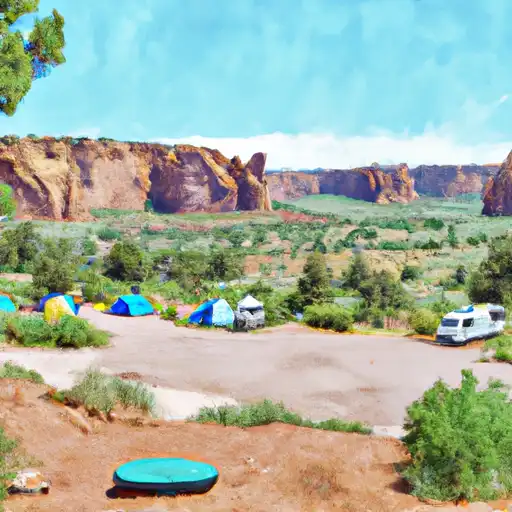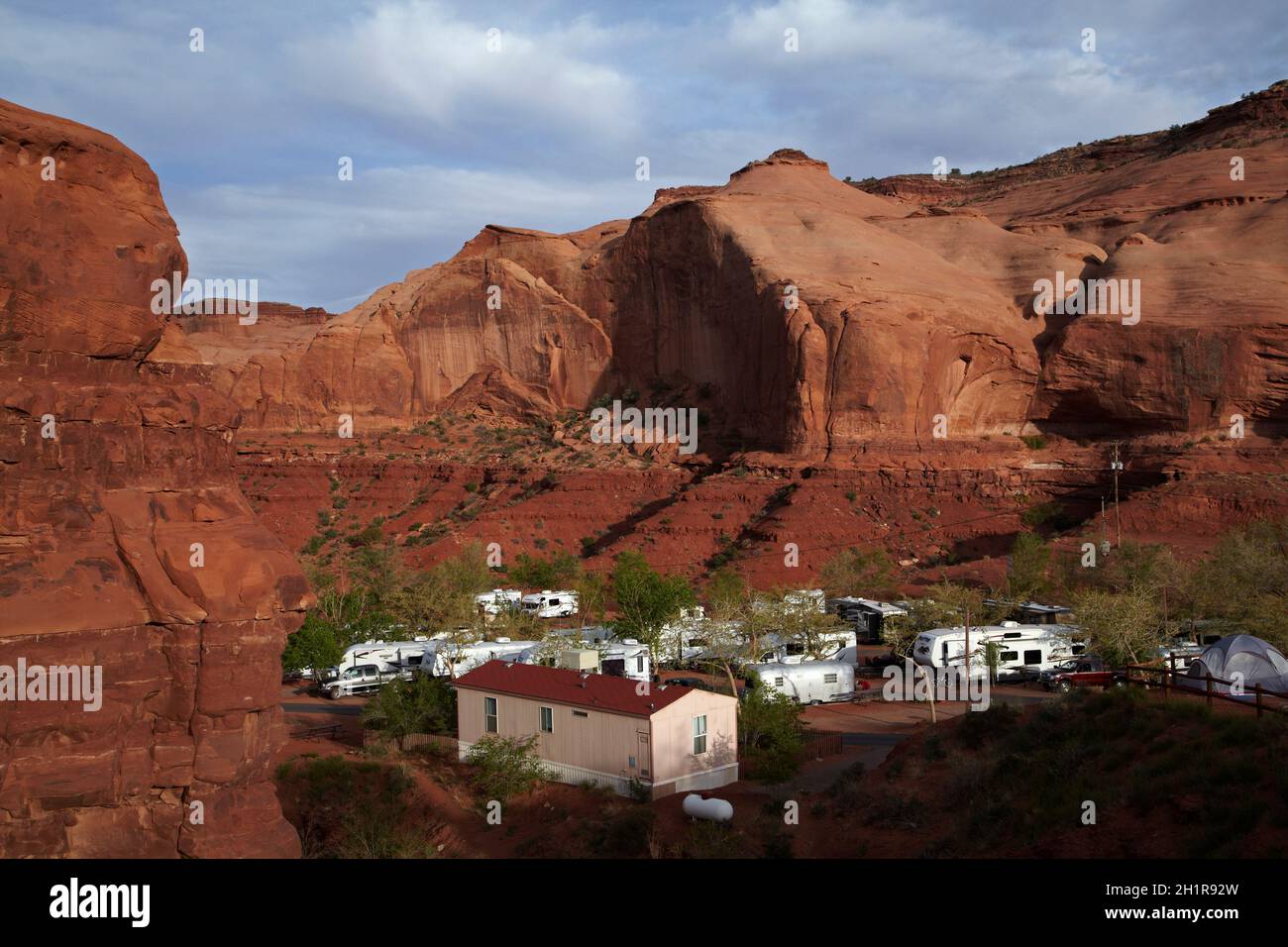
Where Ancient Spirits Whisper: Unveiling the Untamed Beauty of Navajo Nation Camping in Arizona
Arizona, a state synonymous with vast, dramatic landscapes, holds within its borders a sovereign nation whose lands offer an unparalleled camping experience: the Navajo Nation. Covering over 27,000 square miles across Arizona, New Mexico, and Utah, Diné Bikéyah—the Navajo homeland—is larger than ten U.S. states. Within its Arizona expanse, campers can discover a tapestry of iconic monuments, sacred canyons, and boundless backcountry, offering a profound connection to nature and a rich cultural heritage. This is not merely a camping trip; it is an immersion into a living landscape where ancient spirits whisper and the stars shine with an intensity rarely seen.
Diving directly into the heart of the matter, camping within the Navajo Nation is distinct from pitching a tent on federal or state lands. It requires a deep understanding of, and respect for, Diné (Navajo people) culture, their land management practices, and the profound spiritual significance of the environment. The reward for this mindfulness is access to some of the most breathtaking, untouched, and culturally resonant camping spots in North America.
The Allure of Diné Bikéyah: More Than Just Scenery
What sets Navajo Nation camping apart? It’s the confluence of raw, geological grandeur and a vibrant, enduring culture. Imagine waking to the first rays of dawn painting the towering sandstone mesas of Monument Valley in hues of orange and purple, or falling asleep under a sky so thick with stars it feels like you could reach out and touch the Milky Way. Beyond the visual spectacle, there’s an almost palpable sense of history, resilience, and spiritual connection woven into the very fabric of the land.
"This land is our relative," explains a hypothetical Navajo elder, Mr. Tsosie, reflecting a common sentiment. "It provides for us, shelters us, and teaches us. When you camp here, you are not just a visitor; you are a guest in our home, and we ask that you treat it with the same respect we do." This philosophy, rooted in the Diné concept of Hózhó—walking in beauty and balance—is paramount.

Iconic Destinations & Primitive Gems: Where to Pitch Your Tent
The Navajo Nation offers a spectrum of camping experiences, from established campgrounds near famous landmarks to remote, primitive backcountry sites accessible only with local guidance.
1. Monument Valley Navajo Tribal Park
The quintessential image of the American Southwest, Monument Valley, is entirely within the Navajo Nation. Camping here offers an unparalleled opportunity to sleep among the colossal sandstone monoliths that have graced countless postcards and film screens.
- The View Campground: Situated adjacent to The View Hotel, this campground offers RV sites with hookups and tent sites, many boasting direct, unobstructed views of the Mittens and Merrick Butte. Waking up here to watch the sunrise cast long shadows across the valley floor is an unforgettable experience. Reservations are highly recommended, especially during peak season.
- Goulding’s Campground: Located just outside the Tribal Park boundary, Goulding’s offers a full-service campground with amenities, including a pool, general store, and gas station, providing a comfortable base for exploring the area.
While camping at these established sites offers convenience, the real magic lies in guided backcountry tours that often include an overnight stay deeper within the valley, away from the crowds. These tours, led by local Navajo guides, not only provide access to restricted areas but also enrich the experience with cultural insights, traditional stories, and historical context.

2. Canyon de Chelly National Monument
Managed cooperatively by the National Park Service and the Navajo Nation, Canyon de Chelly is a place of profound historical and cultural significance. For over 5,000 years, it has been home to Native Americans, and today, Diné families still live and farm on the canyon floor.
- Cottonwood Campground: Located near the visitor center, this NPS-managed campground offers primitive tent and RV sites (no hookups) on a first-come, first-served basis. While you can’t camp in the canyon without a permit and a guide, Cottonwood provides a peaceful base for exploring the rim drives and overlooks.
- Backcountry Camping (Guided): To truly experience Canyon de Chelly, you must descend into its depths. This requires a certified Navajo guide. While not strictly "camping" in the sense of pitching your own tent, many guided tours offer multi-day excursions where overnight stays in the canyon are arranged, often in traditional hogans or designated primitive sites, providing an intimate connection with this sacred space. These tours delve into ancient cliff dwellings, petroglyphs, and the living history of the canyon.
3. Lake Powell / Antelope Canyon Vicinity (Eastern Shore)
While Antelope Canyon itself is a day-use area requiring guided tours, the vast, rugged lands surrounding the eastern shore of Lake Powell within the Navajo Nation offer incredible primitive camping opportunities for those seeking solitude and dramatic lake views. Areas like Lone Rock Beach (managed by Glen Canyon National Recreation Area) offer designated camping, but much of the surrounding Navajo land is open for dispersed camping with the appropriate permits.
This region is characterized by its mesmerizing slot canyons, hidden coves, and the striking contrast of blue water against red rock. Kayaking, paddleboarding, and fishing (with a Navajo Nation fishing permit) are popular activities. The remote nature means minimal light pollution, making it a prime stargazing location.
4. Little Colorado River Gorge / Grand Canyon East
For the truly adventurous and self-sufficient, the lands bordering the Grand Canyon’s eastern rim, where the Little Colorado River carves its own dramatic gorge before joining the Colorado, offer unparalleled primitive camping. This area is less developed and requires meticulous planning. Access is often via rough dirt roads, and services are nonexistent.
Camping here means breathtaking views of the Grand Canyon’s lesser-seen eastern sections, the unique turquoise waters of the Little Colorado (seasonal), and profound solitude. This is a place for experienced backcountry campers who understand the principles of Leave No Trace and are prepared for extreme weather conditions and remote self-sufficiency. Permits for this specific area are often obtained through local Navajo Chapter Houses or the Navajo Nation Parks & Recreation Department, emphasizing local knowledge and permission.
The Golden Rule: Permitting & Respect
Unlike federal lands where a National Parks Pass might suffice or dispersed camping is broadly allowed, camping on the Navajo Nation always requires a permit. This is the single most crucial piece of information for any prospective camper.
- Navajo Nation Parks & Recreation Department: This is the primary authority for permits in many designated areas and for general backcountry access. Their website is the first point of contact.
- Local Chapter Houses: For very remote, non-designated areas, you may need to obtain permission from the local Navajo Chapter (the equivalent of a county government) that oversees the specific land. This often involves speaking directly with chapter officials or even the local grazing permittee, as much of the land is assigned to individual families for ranching. This process underscores the communal ownership and management of Diné Bikéyah.
- Guides: For areas like the floor of Canyon de Chelly or deep into Monument Valley’s backcountry, a certified Navajo guide is mandatory. These guides are not just navigators; they are cultural ambassadors, ensuring your experience is both safe and respectful. They often handle the necessary permits for their tours.
Key Permitting Facts:
- Permits are typically affordable but vary by location and duration.
- They are essential for legal camping and to ensure your presence is acknowledged and respectful.
- Do not attempt to camp without a permit. Trespassing is taken seriously and undermines the relationship between visitors and the Nation.
Essential Etiquette and Preparation
Camping in the Navajo Nation is a privilege, not a right. Adhering to the following principles is non-negotiable:
- Leave No Trace: This is paramount. Pack out everything you pack in. Bury human waste properly (6-8 inches deep, 200 feet from water, trails, and campsites). Minimize campfire impacts (use existing rings, keep fires small, ensure they are completely out). Do not disturb wildlife or natural features.
- Cultural Sensitivity:
- Photography: Always ask permission before photographing individuals, ceremonies, or private residences (hogans). Respect requests to not photograph certain areas, which may be sacred.
- Sacred Sites: Do not disturb ruins, rock art, or other cultural sites. Look, but do not touch.
- Private Property: Much of the land, even if seemingly open, is part of a grazing lease or private allotment. Always respect boundaries and do not enter private land without explicit permission.
- Alcohol: The Navajo Nation is a dry reservation. Alcohol possession and consumption are strictly prohibited.
- Self-Sufficiency: Services are sparse. Carry ample water (more than you think you’ll need), food, fuel, and emergency supplies. Cell service is often nonexistent in remote areas.
- Weather Preparedness: Arizona’s high desert experiences extreme temperature swings. Summers are scorching, with monsoon thunderstorms possible; winters can be surprisingly cold with snow. Be prepared for sun, wind, dust, and sudden changes.
- Road Conditions: Many roads are unpaved and can become impassable after rain or snow. A high-clearance, 4×4 vehicle is often recommended for accessing remote areas.
The Reward: A Transformative Journey
Beyond the logistical considerations, the reward for respectful and prepared camping in the Navajo Nation is immeasurable. It’s the profound silence broken only by the wind or the distant call of a coyote. It’s the feeling of insignificance yet profound connection beneath an endless canvas of stars. It’s the humbling realization of standing on land that has nurtured a resilient people for millennia.
"When you leave, we hope you take with you not just photographs, but a piece of the beauty and peace you found here," says Mr. Tsosie. "And we hope you leave nothing behind but your footprints and respect."
Camping in the Navajo Nation is an invitation to slow down, listen, and truly connect with a landscape and a culture unlike any other. It demands preparation, humility, and a deep sense of respect, but in return, it offers an experience that will resonate long after you’ve packed away your tent, leaving an indelible mark on your soul. It is, without hyperbole, one of Arizona’s most authentic and deeply rewarding outdoor adventures.

